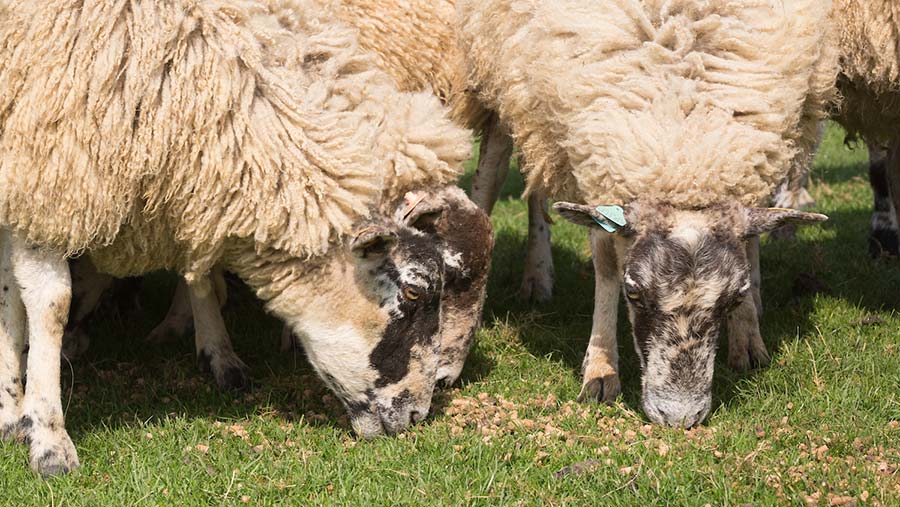How ewe liver tissue tests are helping to fine-tune rations
 © Tim Scrivener
© Tim Scrivener Taking liver biopsies from breeding ewes is helping Welsh sheep farmers to establish the mineral status of their flocks and fine-tune rations.
Testing tissue samples from the livers of live ewes can be costly and is not commonly used in UK flocks.
The technique is, however, widely used in New Zealand to monitor trace element status.
A study in Wales has looked at its usefulness in informing decision-making around the nutrition of breeding ewes to provide a complete picture of flock status when used alongside blood testing and forage sampling.
See also: 6 tips for a good livestock parasite control plan
Trial process
Funding was provided by the European Innovation Project (see bottom of article). The project took place on 12 farms in north Wales. On each one:
- blood and tissue samples were taken from eight ewes pre tupping
- and blood samples were taken from 15 ewes pre-lambing.
This monitoring, which included detailed analysis of the results and advisory reports, cost £1,299.67 (ex VAT) a flock.
Copper and selenium deficiencies
Sampling identified copper deficiencies in two flocks.
Copper is excreted through the liver and the concentration adjusts more slowly over several months than it does in blood.
Vet Joseph Angell, who was involved in the study, says liver copper concentrations allow a better understanding of historic supply, which can enable a more proactive approach to planning nutritional adjustments.
Blood sampling in another flock showed marginally low copper concentrations, but the tissue sample confirmed an above-normal concentration.
There was also a disparity with the selenium concentration in this flock – it was within the normal range in the blood sample but marginally deficient in the liver tissue.
The additional information provided by the liver tissue was, therefore, useful in determining the need and safety of supplementation.
This flock had been supplemented with copper and selenium in previous years, and further copper supplementation could have resulted in toxicity.
Using just blood results for copper would have indicated a small benefit of supplementation, said Dr Angell. While the selenium blood samples showed sufficient absorption, the liver tissue samples proved that without supplementation ewes would have become suboptimal.

Vet Joseph Angell performing a biopsy © Joseph Angell
Cost v benefit
Dr Angell says the cost of sampling needs to be weighed against improved performance and cost savings on trace element supplementation and over-feeding concentrates.
“I would, on balance, suggest liver tissue samples are likely to be useful, particularly during an initial investigation and monitoring phase, as was the situation for the flocks in this project.
“A bolus could cost in the region of £1 per ewe which, if necessary, is likely to deliver a return, yet if not, is an unnecessary cost.’’
Similarly, over-supplying ewes with concentrates pre lambing can result in a large feed bill and health problems associated with overfeeding, Dr Angell added.
“Conversely, under-supplying concentrate feed pre-lambing is likely to result in reduced milk quality and quantity, with disease consequences for both ewes and lambs,’’ he said.
Liver tissue sampling is particularly useful for farmers who don’t know the underlying ability of their sheep to assimilate trace elements, or their response to supplementation.
Biopsy v blood testing
A liver tissue sample provides different information to blood and a much longer-term historical estimation of the status of some trace elements, particularly copper.
This information, coupled with an understanding of the expected nutritional demands of the sheep, and an understanding of the potential available supply, can help to make decisions about nutritional adjustment.
Blood analysis is still useful in combination with liver biopsies because it can provide short-term information on current supply and response, says Dr Angell.
When tissue sampling is the most beneficial
- When optimal production is the goal rather than the investigation of a clinical disease or syndrome
- If sheep change pastures regularly
- When pastures have different mineral concentrations
- When borderline cases are identified, the extra data allows decisions to be better informed
EIP Wales aims to take the outcomes from research, whether it’s a new technique or technology, and test them at farm scale. There are currently 39 projects across Wales that bring like-minded people from different backgrounds together to try and solve common agricultural problems.
EIP Wales, which is delivered by Menter a Busnes and Farming Connect, has received funding through the Welsh Government Rural Communities – Rural Development Programme 2014-2020, which is funded by the European Agricultural Fund for Rural Development and the Welsh Government.
